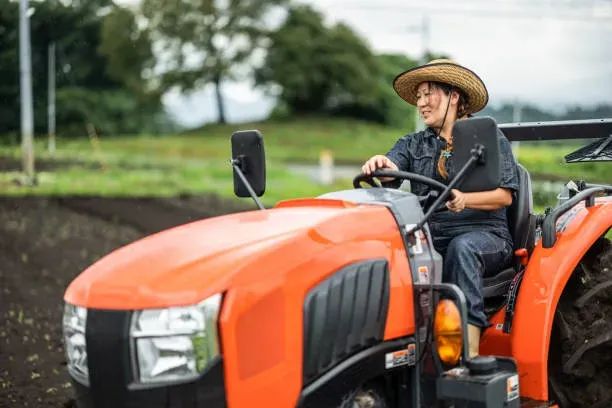Selecting the appropriate tractor horsepower is essential for optimizing farm operations, ensuring efficiency, and managing costs effectively. The ideal tractor size varies based on farm size, terrain, soil conditions, and specific agricultural tasks.
Understanding Tractor Horsepower Ratings
Tractor horsepower ratings are categorized as follows:
-
Engine Horsepower (Gross HP): The total power output of the engine before losses.
-
Power Take-Off (PTO) Horsepower: The power available to operate implements like balers, mowers, and sprayers. It’s usually 15-25% lower than engine horsepower due to power loss in the drivetrain.
-
Drawbar Horsepower: The power available for pulling loads (plows, harrows, trailers). It’s lower than both engine and PTO horsepower due to friction and transmission losses.
Assessing Farm Size and Terrain
The required tractor horsepower varies with farm size and terrain:
-
Small Farms (Less than 10 Acres): Ideal for compact or sub-compact tractors with 15-40 HP, suitable for mowing, tilling, light hauling, and loader work.
-
Medium Farms (10-100 Acres): Utility tractors with 40-100 HP are appropriate for row crops, hay production, livestock care, and general fieldwork.
-
Large Farms (100+ Acres): High-horsepower tractors ranging from 100-200 HP are necessary for large-scale plowing, planting, harvesting, and heavy-duty applications.
Matching Horsepower to Farm Activities
Aligning tractor horsepower with specific farm tasks is crucial:
-
Mowing and Light Work: Compact tractors (15-40 HP) are ideal for lawn mowing and light brush clearing.
-
Tillage and Soil Preparation: Larger tractors (40-200+ HP) are required for plowing, disking, and tilling. A general rule is 15 HP per bottom plow; for example, a 3-bottom plow requires approximately 45 HP.
-
Hay and Forage Operations: Medium to large tractors (50-150 HP) are suitable for cutting, raking, and baling hay. For round balers, a minimum of 60-100 HP is recommended.
-
Row Crop Farming: Large row-crop tractors (100-300+ HP) are necessary for seed drilling, spraying, fertilizing, and harvesting. A general guideline is 10 HP per row on row-crop planters.
-
Livestock and Material Handling: Utility tractors (40-100 HP) are suitable for feeding livestock, moving hay bales, and manure handling. For handling large round hay bales, 60+ HP is recommended.
Evaluating Terrain and Soil Conditions
Terrain and soil conditions influence the required tractor horsepower:
-
Flat Terrain: Lower HP can perform well on level fields and smooth surfaces.
-
Hilly or Uneven Terrain: Requires extra horsepower for climbing and maintaining traction.
-
Heavy Clay or Rocky Soil: Heavy soils increase drag and implement resistance, necessitating higher HP tractors with additional torque.
A general recommendation is to add 10-20% more HP for challenging soil conditions.
Fuel Efficiency and Cost Considerations
Choosing the right tractor horsepower impacts fuel efficiency and operating costs:
-
Diesel vs. Gasoline Tractors: Diesel engines are more fuel-efficient and offer higher torque for heavy-duty work, making them suitable for larger tractors.
-
Cost of Ownership: Larger HP tractors consume more fuel per hour, increasing operating costs. Selecting the appropriate HP for the job helps avoid excessive fuel use.
Future Expansion and Implement Compatibility
When selecting a tractor, consider future farm growth and the need for compatibility with various implements:
-
Plan for Growth: Choose a tractor that meets both current and future farm needs to avoid frequent upgrades.
-
Implement Compatibility: Ensure the tractor’s PTO and hydraulic capacity are suitable for additional attachments.
For instance, a 60 HP tractor may suffice now, but if hay operations expand, a 100 HP tractor might be a better long-term investment.
General Horsepower Recommendations
Here are general horsepower recommendations based on farm size:
| Farm Size | Recommended HP | Best For |
|---|---|---|
| Small Farms (<10 acres) | 15-40 HP | Mowing, gardening, light tillage |
| Medium Farms (10-100 acres) | 40-100 HP | Row crops, hay baling, plowing |
| Large Farms (100+ acres) | 100-300+ HP | Large-scale farming, heavy tillage, row crops |
Selecting the appropriate tractor horsepower is vital for farm efficiency and productivity. By considering farm size, terrain, soil conditions, and specific tasks, farmers can make informed decisions that align with their operational needs and future growth plans.

